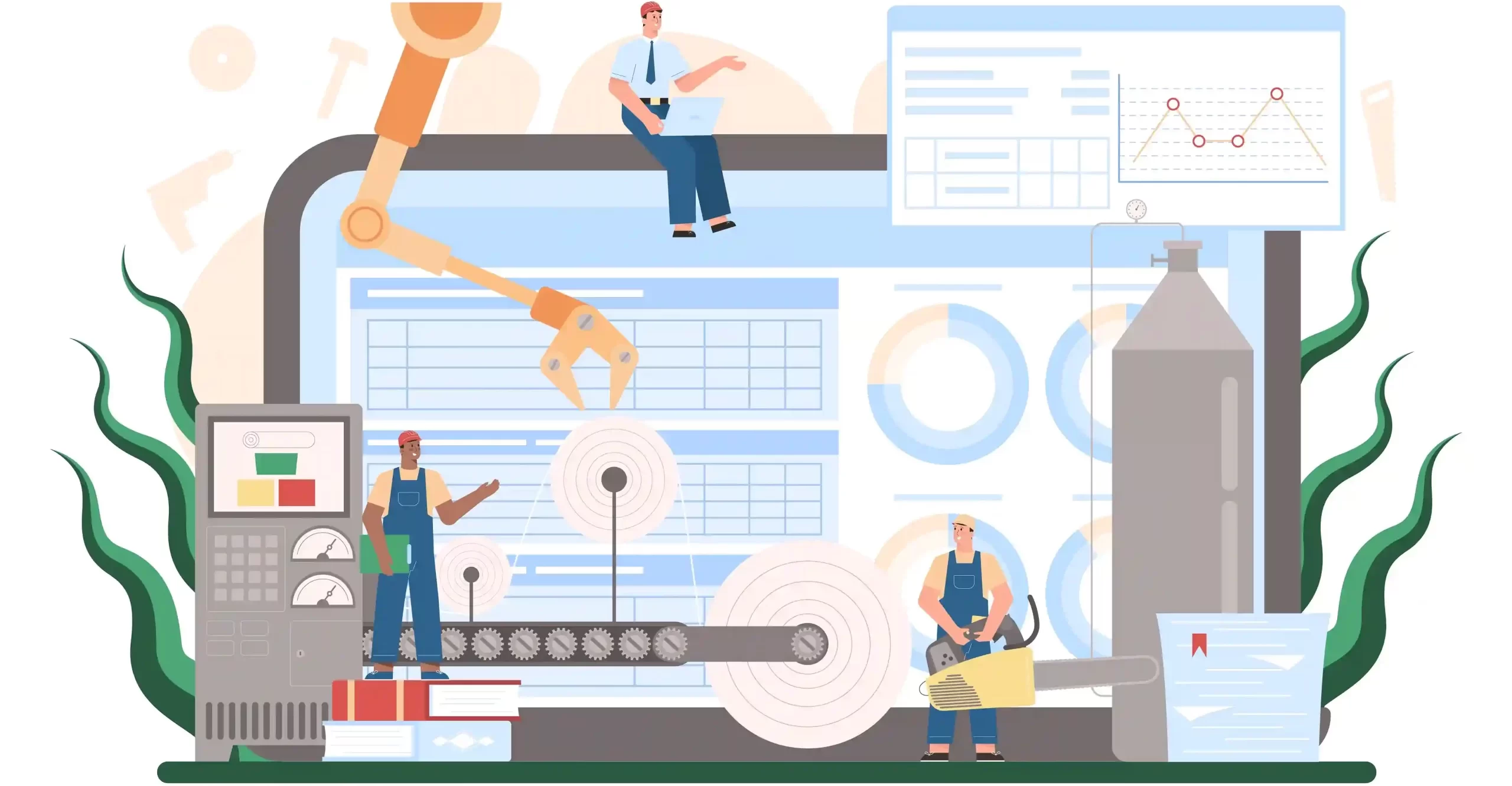Industry 4.0: Transforming Manufacturing with Digital Technologies
Author: Inza Khan
25 July, 2024
The convergence of digital technologies with traditional manufacturing processes is bringing a new era of innovation, efficiency, and competitiveness. This change, known as Industry 4.0, is redefining how products are designed, produced, and delivered. From smart factories and artificial intelligence to the Internet of Things and advanced analytics, digital transformation is not just changing manufacturing – it’s reimagining it. This blog explores how digital transformation drives innovation, reshapes business models, and sets new standards for the future of manufacturing.

What Is Digital Transformation in Manufacturing?
Digital transformation in manufacturing refers to the integration of digital technologies into all areas of a manufacturing business, fundamentally changing how it operates and delivers value to customers. This transformation goes beyond merely digitizing existing processes; it involves a complete reimagining of the manufacturing ecosystem, from product design and production to supply chain management and customer service.
Key components of digital transformation in manufacturing include:
Industry 4.0 Technologies
The adoption of technologies such as the Internet of Things (IoT), artificial intelligence, machine learning, robotics, and advanced analytics. These technologies form the backbone of smart manufacturing, enabling real-time data collection, analysis, and automated decision-making. For instance, IoT sensors can monitor equipment performance, while AI algorithms can predict maintenance needs, optimizing overall equipment effectiveness (OEE).
Smart Factories
The creation of intelligent, interconnected manufacturing facilities where machines communicate with each other and with humans in real-time. Smart factories leverage technologies like Industrial IoT (IIoT) to create a networked environment where every aspect of the production process is monitored and optimized. This includes automated guided vehicles (AGVs) for material handling, collaborative robots working alongside humans, and real-time production scheduling systems.
Data Analytics for Decision-Making
Utilizing big data and analytics to make informed, strategic decisions across all levels of the organization. This involves collecting vast amounts of data from various sources (production lines, supply chain, customer feedback, etc.), using advanced analytics tools to derive insights, and implementing data visualization techniques to make these insights accessible to decision-makers. For example, predictive analytics can forecast demand patterns, helping manufacturers optimize inventory levels and production schedules.
Advancing Production with Digital Twin Technology
Creating virtual replicas of physical assets, processes, or systems to simulate and optimize operations. Digital twins allow manufacturers to test scenarios, predict outcomes, and optimize processes in a risk-free virtual environment before implementing changes in the real world. This technology can be applied to individual machines, entire production lines, or even complete factories, enabling continuous improvement and innovation.
Additive Manufacturing
Implementing 3D printing and other additive manufacturing techniques for rapid prototyping and custom production. This technology enables manufacturers to produce complex geometries, reduce material waste, and offer mass customization. For instance, aerospace manufacturers use additive manufacturing to produce lightweight, complex parts that were previously impossible or too expensive to manufacture using traditional methods.
Cloud Computing
Using cloud-based solutions for improved data storage, processing, and accessibility. Cloud platforms provide the scalability and flexibility needed to handle the massive amounts of data generated in modern manufacturing environments. They also facilitate collaboration across different sites and with external partners, enabling real-time sharing of design files, production data, and supply chain information.
Why Manufacturers Need Digital Transformation?
The need for digital transformation in manufacturing is driven by several factors:
- Increasing Global Competition: As markets become more interconnected, manufacturers face competition from around the world. Digital transformation enables companies to improve efficiency, reduce costs, and stay competitive.
- Changing Customer Expectations: Modern customers demand personalized products, faster delivery times, and greater transparency. Digital technologies help manufacturers meet these expectations through customization, improved supply chain visibility, and enhanced communication.
- Sustainability Pressures: With growing environmental concerns, manufacturers are under pressure to reduce their carbon footprint. Digital technologies can help in monitoring and reducing energy consumption, waste, and emissions.
- Workforce Evolution: As skilled workers retire and new generations enter the workforce, there’s a need for more intuitive, technology-driven work environments that attract and retain talent.
- Supply Chain Resilience: Recent global events have highlighted the importance of adaptable and resilient supply chains. Digital transformation enables better visibility and agility in supply chain management.
Benefits of Digital Transformation in Manufacturing
- Improved Quality Control: Advanced sensors and machine learning algorithms can detect defects and inconsistencies in real-time, ensuring higher product quality.
- Cost Reduction: Optimized processes, predictive maintenance, and efficient resource utilization lead to substantial cost savings.
- Better Customer Experience: Personalization capabilities and improved communication channels enhance customer satisfaction and loyalty.
- Improved Safety: Automation of dangerous tasks and real-time monitoring of safety parameters create a safer work environment.
- Faster Time-to-Market: Digital design tools and rapid prototyping technologies accelerate product development cycles.
Steps to Implement Digital Transformation in Manufacturing
1. Assess Current State
Conduct a thorough evaluation of existing processes, technologies, and organizational culture to identify areas for improvement. This may involve process mapping, technology audits, and employee surveys to understand current capabilities and pain points.
2. Define Clear Objectives
Set specific, measurable goals for your digital transformation initiative, aligned with overall business objectives. These might include targets for productivity improvement, cost reduction, quality enhancement, or new product introduction timelines.
3. Develop a Roadmap
Create a detailed plan outlining the steps, technologies, and resources needed to achieve your digital transformation goals. This should include a timeline, budget, and key performance indicators (KPIs) to measure progress.
4. Secure Leadership Buy-In
Ensure top-level management understands and supports the digital transformation initiative. This may involve presenting business cases, ROI projections, and competitive analyses to demonstrate the necessity and potential benefits of digital transformation.
5. Build a Cross-Functional Team
Assemble a diverse team with representatives from IT, operations, HR, and other relevant departments to drive the transformation. This team should have the authority to make decisions and the expertise to guide implementation across different areas of the organization.
6. Invest in Infrastructure
Upgrade your IT infrastructure to support new digital technologies, including robust networks, cloud systems, and cybersecurity measures. This may involve implementing 5G networks for improved connectivity, migrating to cloud-based ERP systems, or enhancing data center capabilities.
7. Start with Pilot Projects
Begin with small-scale implementations to test new technologies and processes, learn from the experience, and scale successful initiatives. For example, you might start by implementing IoT sensors on a single production line before rolling out to the entire factory.
8. Focus on Data Integration
Ensure that data from various sources can be collected, analyzed, and shared seamlessly across the organization. This might involve implementing data lakes, developing APIs for legacy systems, or adopting industrial data platforms that can handle diverse data types and sources.
9. Prioritize Cybersecurity
As systems become more interconnected, implement robust cybersecurity measures to protect sensitive data and operations. This includes regular security audits, employee training on cybersecurity best practices, and implementing advanced threat detection and response systems.
10. Invest in Training and Change Management
Provide comprehensive training to employees and implement change management strategies to ensure smooth adoption of new technologies and processes. This might involve creating digital learning platforms, organizing hands-on workshops, and developing mentorship programs to support skill development.
11. Promote a Culture of Learning
Encourage experimentation, continuous learning, and adaptation to new technologies and ways of working. This could include establishing innovation labs, organizing hackathons, or implementing reward systems for employee-driven improvements.
12. Measure and Iterate
Continuously monitor the progress of your digital transformation initiatives, measure their impact, and make adjustments as needed. Use data analytics to track KPIs, conduct regular reviews, and be prepared to pivot strategies based on results and changing market conditions.
Conclusion
At Xorbix Technologies, we specialize in digital transformation solutions, offering tailored strategic roadmaps, technology assessment and integration, advanced data analytics, process redesign and optimization, and robust progress tracking. Our comprehensive approach ensures your business can utilize the power of digital technologies to drive innovation, improve efficiency, and achieve long-term success. Partner with Xorbix to confidently embrace change, achieve sustainable growth and lead the future of manufacturing.
Read more on related topics:




